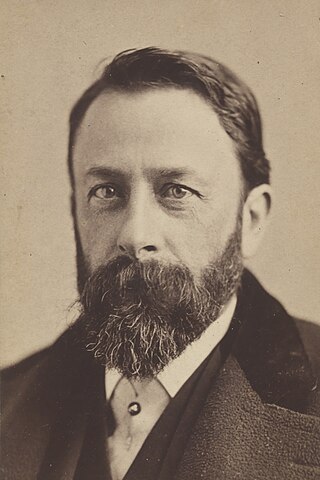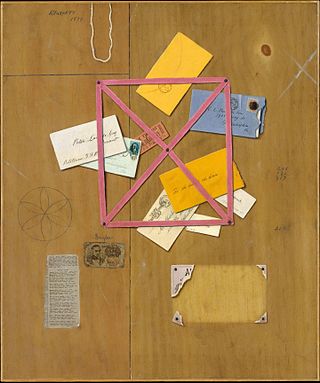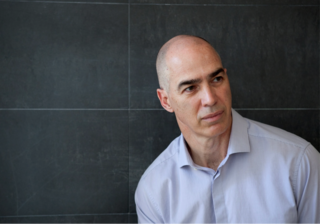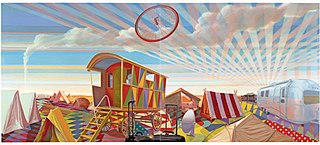Related Research Articles

Albert Bierstadt was a German American painter best known for his lavish, sweeping landscapes of the American West. He joined several journeys of the Westward Expansion to paint the scenes. He was not the first artist to record the sites, but he was the foremost painter of them for the remainder of the 19th century.

William Michael Harnett was an American painter known for his trompe-l'œil still lifes of ordinary objects.

Homer Ransford Watson was a Canadian landscape painter. He has been characterized as the painter who first painted Canada as Canada, rather than as a pastiche of European painting. He was a member and president (1918–1922) of the Royal Canadian Academy of Arts, as well as a founding member and first president (1907–1911) of the Canadian Art Club. Although Watson had almost no formal training, by the mid-1920s he was well known and admired by Canadian collectors and critics, his rural landscape paintings making him one of the central figures in Canadian art from the 1880s until the First World War.

Louis-Léopold Boilly was a French painter and draftsman. A creator of popular portrait paintings, he also produced a vast number of genre paintings documenting French middle-class social life. His life and work spanned the eras of monarchical France, the French Revolution, the Napoleonic Empire, the Bourbon Restoration and the July Monarchy. His 1800 painting Un Trompe-l'œil introduced the term trompe-l'œil, applied to the technique that uses realistic imagery to create the optical illusion that the depicted objects exist in three dimensions, though the "unnamed" technique itself had existed in Greek and Roman times.
The Blue Period comprises the works produced by Spanish painter Pablo Picasso between 1901 and 1904. During this time, Picasso painted essentially monochromatic paintings in shades of blue and blue-green, only occasionally warmed by other colors. These sombre works, inspired by Spain and painted in Barcelona and Paris, are now some of his most popular works, although he had difficulty selling them at the time.

Ellsworth Kelly was an American painter, sculptor, and printmaker associated with hard-edge painting, Color field painting and minimalism. His works demonstrate unassuming techniques emphasizing line, color and form, similar to the work of John McLaughlin and Kenneth Noland. Kelly often employed bright colors. He lived and worked in Spencertown, New York.
William Ronald Smith, known professionally as William Ronald, was an important Canadian painter, best known as the founder of the influential Canadian abstract art group Painters Eleven in 1953 and for his abstract expressionist "central image" paintings. He was the older brother of painter John Meredith (1933–2000).
Karl Wirsum was an American artist. He was a member of the Chicago artistic group The Hairy Who, and helped set the foundation for Chicago's art scene in the 1970s. Although he was primarily a painter, he also worked with prints, sculpture, and even digital art.

Haystacks is the common English title for a series of impressionist paintings by Claude Monet. The principal subject of each painting in the series is stacks of harvested wheat. The title refers primarily to a twenty-five canvas series which Monet began near the end of the summer of 1890 and continued through the following spring, though Monet also produced five earlier paintings using this same stack subject. A precursor to the series is the 1884 Haystack Near Giverny.
Allan D'Arcangelo was an American artist and printmaker, best known for his paintings of highways and road signs that border on pop art and minimalism, precisionism and hard-edge painting, and also surrealism. His subject matter is distinctly American and evokes, at times, a cautious outlook on the future of this country.
Joe Goode, is an American visual artist, known for his pop art paintings. Goode made a name for himself in Los Angeles, California, through his cloud imagery and milk bottle paintings which were associated with the Pop Art movement. The artist is also closely associated with Light and Space, a West Coast art movement of the early 1960s. He resides in Los Angeles, California.
The Chicago Imagists are a group of representational artists associated with the School of the Art Institute of Chicago who exhibited at the Hyde Park Art Center in the late 1960s.

Paul Feeley was an artist and director of the Art Department at Bennington College during the 1950s and early 1960s.
Andrew Bucci was an American artist from Mississippi.
Gladys M. Nilsson is an American artist, and one of the original Hairy Who Chicago Imagists, a group of representational artists active during the 1960s and 1970s. She is married to fellow-artist and Hairy Who member Jim Nutt.

Anthony Morse Urquhart, LL.D. was a Canadian painter. He was recognized in the late 1950s and early 1960s as one of Canada's pioneering abstractionists, having been variously linked with the Toronto painters associated with The Isaacs Gallery and The Heart of London group that included Jack Chambers, Greg Curnoe and Murray Favro.

David Klamen is an American artist and academic. He is known for visually diverse paintings that meld technical mastery with postmodern explorations of the processes by which humans understand and interpret experience. Klamen has exhibited across the United States, Europe and Asia, including individual shows at the Museum of Contemporary Art Chicago (MCA), the Chazen Museum of Art and the Cedar Rapids Museum of Art, and major group exhibitions at the Metropolitan Museum of Art, the Art Institute of Chicago, the Museum of Contemporary Art, San Diego, the Indianapolis Museum of Art, and the Crocker Art Museum. His work sits in the permanent collections of the Metropolitan Museum of Art, the Los Angeles Museum of Contemporary Art and the Whitney Museum of American Art, among others. Klamen has been based in Chicago for most of his career, which includes being an educator for over thirty years, primarily at Indiana University Northwest, where he was appointed Founding Dean, School of the Arts in 2018.
Richard Shaw is an American ceramicist and professor known for his trompe-l'œil style. A term often associated with paintings, referring to the illusion that a two-dimensional surface is three-dimensional. In Shaw's work, it refers to his replication of everyday objects in porcelain. He then glazes these components and groups them in unexpected and even jarring combinations. Interested in how objects can reflect a person or identity, Shaw poses questions regarding the relationship between appearances and reality.

Greg Drasler is an American artist known for metaphorical paintings that mix vernacular imagery and decoration and visual and interpretive conundrums. His work explores the construction of identity and memory through painted subjects that range from elaborately constructed interiors to symbolic common objects to patterned panoramas of the American highway. Although representational, Drasler's work eludes defined aesthetic categories such as realism, incorporating elements of surrealism, abstraction, and postmodern bricolage and recontextualization. In an early Art in America review, Robert G. Edelman wrote that Drasler "shares with Magritte the ability to create images that are both convincing and profoundly disorienting"; Jonathan Goodman described his later paintings as enigmatic puzzles meant to be meditated on, as both "visual metaphors for self" and formal statements existing for the sake of psychological mystery. Drasler has been awarded a Guggenheim Fellowship and grants from the Pollock-Krasner Foundation, National Endowment for the Arts and New York Foundation for the Arts. His work has been shown at the New Museum, PS1, Whitney Museum Stamford, Artists Space and Carnegie Museum of Art, and reviewed or featured in Art in America, Flash Art, New Art Examiner, The Paris Review, and The New York Times. Drasler lives in Tribeca, New York City with his wife, artist Nancy Davidson, and teaches at Pratt Institute.

John Hall is a Canadian modernist painter from Alberta, known for his highly realistic painting style.
References
- ↑ Loos, Ted (April 3, 2017). "Chicago to Take the Spotlight With Ambitious 2018 Art Event". New York Times. Retrieved 30 May 2017.
- 1 2 3 4 5 6 7 Art Green: Certain Subjects. New York: Garth Greenan Gallery. 2013. ISBN 9780989890212.
- 1 2 3 Gruber, Terry (1977). "Art Green". Arts Magazine. 51 (9): 16.
- 1 2 Applegate, Judith (1970). "Paris Letter". Art International. 14 (5): 65.
- 1 2 3 4 5 6 7 8 9 10 Enright, Robert (2005). "Green's Party". Border Crossings. 24 (4).
- ↑ Halstead, Whitney (1966). "Chicago". Artforum. 4 (10): 56.
- ↑ Heavy Weather: Art Green Retrospective. Kitchener: Kitchener-Waterloo Art Gallery. 2005. ISBN 0973818018.
- ↑ Schulze, Franz (1966). "Chicago Popcycle". Art in America. 54 (6): 103.
- ↑ Halstead, Whitney (1967). "Chicago". Artforum. 5 (9): 66.
- ↑ Urquhart, Jane (1979). "Waterloo: Art Green". ArtsCanada (226/227): 64.
- 1 2 Adrian, Dennis (1974). "Chicago: Art Green at Phyllis Kind". Art in America. 62 (4): 91–92.
- 1 2 Frank, Peter (1977). "Art Green". Art News. 76 (3): 144.
- 1 2 Johnson, Ken (February 27, 2009). "Art in Review: Art Green". The New York Times. Retrieved 31 May 2017.
- ↑ Argy, Andy (1986). "Art Green". New Art Examiner. 13 (8): 53–54.
- 1 2 Moser, Charlotte (1986). "Art Green". Art News. 85 (4): 142–143.
- ↑ Glatt, Cara (August 18, 1999). "Hairy Who gets up close and personal". Hyde Park Herald: 10.
- ↑ "Delicate Situation - Online Collection". Akron Art Museum. Retrieved 31 May 2017.
- ↑ "Search Collections Results". The Art Institute of Chicago. The Art Institute of Chicago. Retrieved 31 May 2017.
- ↑ "Valparaiso Poetry Review". Valparaiso University. Retrieved 31 May 2017.
- ↑ "Search". Canada Council Art Bank. Retrieved 31 May 2017.
- ↑ "Green, Art, Conflicting Evidence, 1974". Dalhousie Art Gallery. Retrieved 31 May 2017.
- ↑ "Collections". Smart Museum of Art. University of Chicago. Retrieved 31 May 2017.[ permanent dead link ]
- ↑ "Thin Ice". mumok. Retrieved 31 May 2017.
- ↑ "Collection: Art Green, Rigorous Timidity, 1970". MCA. MCA Chicago. Retrieved 31 May 2017.
- ↑ "Collection Search Results". NGA. Retrieved 31 May 2017.
- ↑ "The Collection". PAFA. Retrieved 31 May 2017.
- ↑ "Pure Fabrication by Art Green". Smithsonian American Art Museum. Retrieved 31 May 2017.
- ↑ "Face Value". Yale University Art Gallery. Yale University. Retrieved 31 May 2017.
- ↑ "Members since 1880". Royal Canadian Academy of Arts. Archived from the original on 26 May 2011. Retrieved 11 September 2013.